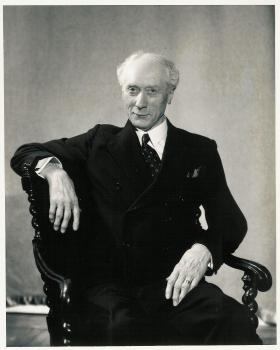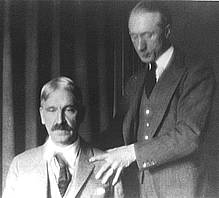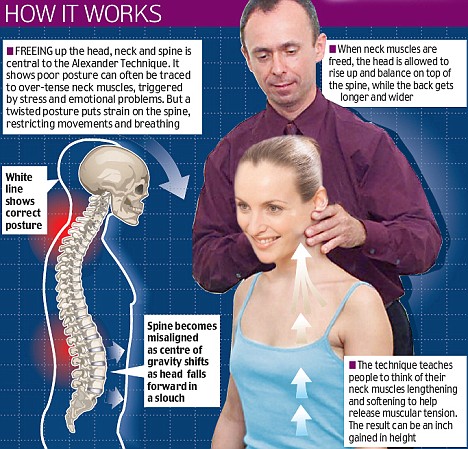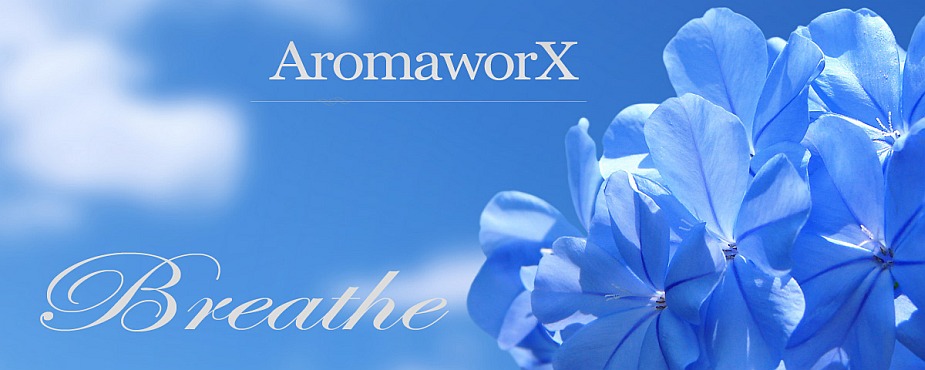The F.M. Alexander Technique
- Details
- Written by AndEl

by Marian Goldberg
We are often unaware of habits that cause us stress and interfere with our ability to respond effectively to the stimuli in our daily lives. How can we change our habits so that we can respond more effectively and achieve better functioning? This fundamental problem is addressed and dealt with in the Alexander Technique, a method that has been recognized for one-hundred years as a unique and remarkably-effective technique of mind-body reeducation.
A Brief History
 F. Matthias Alexander (1869-1955) was an Australian actor and teacher. He originally developed the Alexander Technique as a method of vocal training for singers and actors in the 1890s. While Alexander was developing his method of voice training, he realized that the basis for all successful vocal education was an efficiently and naturally functioning respiratory mechanism. So, in teaching voice, Alexander focused primarily on helping the breathing mechanism to function more effectively. Because of his focus on "reeducating" the breathing mechanism, some of Alexander's students, who had come to him for vocal training, found that their respiratory difficulties also improved. These improvements were recognized by medical doctors who began referring their patients with respiratory ailments to Alexander for help. In this way, F.M. Alexander's technique of vocal training developed into a technique he termed "respiratory re-education."
F. Matthias Alexander (1869-1955) was an Australian actor and teacher. He originally developed the Alexander Technique as a method of vocal training for singers and actors in the 1890s. While Alexander was developing his method of voice training, he realized that the basis for all successful vocal education was an efficiently and naturally functioning respiratory mechanism. So, in teaching voice, Alexander focused primarily on helping the breathing mechanism to function more effectively. Because of his focus on "reeducating" the breathing mechanism, some of Alexander's students, who had come to him for vocal training, found that their respiratory difficulties also improved. These improvements were recognized by medical doctors who began referring their patients with respiratory ailments to Alexander for help. In this way, F.M. Alexander's technique of vocal training developed into a technique he termed "respiratory re-education."
Alexander had also made the discovery that breathing and vocalization are part and parcel of how the body functions as a whole. Habitual breathing and vocal patterns are parts of habitual patterns of general coordination. In fact, many problems we see as involving just one particular part of the body, e.g. lower back pain and "RSI," are often symptoms of larger habitual patterns of malcoordination.
Just as people had found Alexander's "vocal" technique helped them with their breathing problems, so a number of his students found his method of respiratory re-education helped them with other physical difficulties. Basically, Alexander had evolved a method for learning how to consciously change maladaptive habits of coordination. (Coordination includes movement, posture, breathing, and tension patterns.) He had come to the understanding that the mind and body function as an integrated entity, a rather unusual realization for that time. Alexander found that habits, whether "physical" habits or "mental" habits, are all psychophysical in nature. He observed that how we think about our activities determines how we coordinate ourselves to do those activities, and, equally, how long-held habits of excessive tension and inefficient coordination affect how we feel and think. In a relatively short period of time, Alexander evolved his technique from a method of vocal training into a method of breathing reeducation and then into a comprehensive technique of psychophysical reeducation. His technique deals with the psychophysical coordination of the whole person, or what he termed more concisely as "the use of the self."
How Habits Affect Our Functioning
How do habits develop? We can see how habits develop by observing the movements of a child. Babies are usually born with an overall fundamental pattern of coordination "programmed" into their nervous systems. This primary pattern works efficiently and easily with the human structure. An example of this natural efficiency of the human mechanism can be seen with a baby who spontaneously sits up by himself. Generally, a baby of 12 months sits very upright naturally. In fact, it is far easier and more natural for a baby to sit upright than for the typical adult who slouches into a supposedly "relaxed" movement/postural pattern. As a child grows, he usually starts to imitate the mannerisms of those around him, such as parents, peers, and teachers. These "imitations" often become permanent and the child will probably lose any conscious awareness that he is doing them. The child may also experience injuries or other uncomfortable experiences which lead to fixed, inefficient habits. These habits can become a constant interference with his natural fundamental coordination. This on-going interference can affect how his muscles develop, how he moves, how he breathes, and how his alignment and posture develop. Most importantly, the child's (and adult's) senses of movement (kinesthetic sense) and balance can become skewed by relying on long-term, fixed habits. These senses are then unable to function as reliable guides for efficient coordination. Though the child or adult may eventually sense that something is wrong with his movement, posture, or other aspects of his functioning, his senses involved in coordination (proprioception) have become so altered by his habits that he finds he can't rely on these senses when he tries to make changes and improvements. The on-going interference of his habits may be causing him excessive and constant stress but the child or adult finds it difficult to "stop" his habits because they feel familiar and "right" to him.
Maladaptive habits alter our general sensory feedback. They alter our perceptions of what feels "right": These altered perceptions and concomitant feelings affect everything we do which involves our coordination. And all activities, whether "physical" or "mental," involve coordination, or the way we use ourselves.
Learning the Alexander Technique
What one learns in Alexander Technique lessons is a unique and practical means of stopping and changing habits. This learning process allows one's sense of coordination to regain its natural "perspective." The Alexander Technique teacher takes the student through basic movements giving gentle hands-on guidance. Through this guidance, the student experiences more natural and easy coordination without the on-going interference of habits. Repeating these experiences of natural, fundamental movement stimulates the student's internal coordination mechanisms to become more accurate. This develops his/her ability to choose better coordinated and non-stressful responses to stimuli. The student is able to make lasting habit changes.
The Alexander Technique does not involve exercises, medical therapy or treatment, forms of psychotherapy, or spiritual healing techniques. It is also unlike the manipulations of bodywork or manual healing techniques: Rather than looking at the body as a set of separate "parts" or pressure points to be individually "worked on," a skilled teacher guides a student through movement, observing and working with whole patterns of coordination, which include tension and postural patterns, how a student thinks about moving, and active movement itself. The student actively participates in this fascinating process, learning to apply his/her own intelligence to effectively change habits.
Benefits
This learning process can have many benefits, including freer and more comfortable movement, relief from strain, chronic pain, and excess tension, more comfortable and erect posture, easier and healthier breathing, increased vitality and strength, and most importantly, the development of skills that can be used to change habits that interfere with optimal functioning. The fundamental improvement in the reliability of sensory appreciation/feedback that occurs with Alexander Technique lessons can have positive, significant effects on a wide range of behaviors and skills, including the ability to learn.
The Technique can be very helpful for people dealing with chronic pain, excessive stress, or injury. It is also used by performing artists to enhance performing techniques. A number of universities and conservatories incorporate the Alexander Technique into their regular curriculum. John Dewey, the American philosopher, studied the technique for over 35 years and expressed a strong wish that the Alexander Technique be incorporated into the educational system. Charles Sherrington, the Nobel laureate in physiology, stated of Alexander's work, "Mr. Alexander has done a service to the subject by insistently treating each act as involving the whole integrated individual, the whole psychophysical man."
Lessons
An Alexander Technique student learns to change tension habits that have been built up over a course of a lifetime. Private lessons focus on the individual student learning and applying the Principles of the Technique in ways that are most effective and beneficial for him/her. The number of lessons a student may choose to take can be based on several factors, including his or her individual conditions, rate of progress, and the particular improvements he or she may be seeking.
F. M. Alexander generally recommended that students take at least thirty private lessons. While most students experience significant improvements with fewer lessons, a series of thirty lessons provides students with the best opportunity to make very substantial and lasting positive changes in deep-rooted tension habits. A series also provides students with the instruction and time needed to learn the Principles of the Technique well enough to continue to progress on their own after they stop taking lessons.
A prospective student usually takes an introductory lesson(s), and then decides if he/she would like to continue taking lessons. It's recommended that new students take lessons at least one or more times a week. Generally, it's better to have lessons one or more times a week than to have lessons less frequently over a longer period of time.
For people who are unable to take lessons on a regular basis, a series of lessons can be taken in smaller sets. For example, a person may take a set of three to five lessons and then have another set of three to five lessons several weeks or months later. Between sets of lessons, the student can use what he/she has learned to help maintain improvement and awareness.
Classes and Workshops
 Although F. M. Alexander did briefly try at one point early in his teaching career to teach the Technique to a group class, he apparently did not find this effective, particularly in comparison to private lessons that focus on each individual's unique habits and use. Despite that Alexander greatly enjoyed and had considerable success with speaking and performing to groups as an actor and reciter, he chose to teach his Technique on an individual basis through private lessons throughout the almost 60 years he taught his Technique. The only other exceptions to this were small classes with people who already had a considerable number of private lessons: his teacher-training course and, for a few years, a small class for children. In his teaching, speaking, and writing, Alexander always emphasized the importance of the individual.
Although F. M. Alexander did briefly try at one point early in his teaching career to teach the Technique to a group class, he apparently did not find this effective, particularly in comparison to private lessons that focus on each individual's unique habits and use. Despite that Alexander greatly enjoyed and had considerable success with speaking and performing to groups as an actor and reciter, he chose to teach his Technique on an individual basis through private lessons throughout the almost 60 years he taught his Technique. The only other exceptions to this were small classes with people who already had a considerable number of private lessons: his teacher-training course and, for a few years, a small class for children. In his teaching, speaking, and writing, Alexander always emphasized the importance of the individual.
Classes and workshops can serve as a limited introduction to the Technique and can offer some helpful hints. However, since classes and workshops attempt to teach the Alexander Technique in a group setting, there are some obvious basic problems with them: they lack sufficient experience in the hands-on guidance integral to learning the Technique and at best they offer a cursory presentation of the Technique. Alexander also wrote in his books about the problems people have with the dynamics of what today might be called "group think." This is very likely another reason he emphasized learning the Technique on an individual basis through private lessons.
Alexander Technique Teacher Training
Standard criteria for teacher training were established over 70 years ago by F. Matthias Alexander. Teacher training in the Alexander Technique is a unique process, quite unlike trainings in other methods and disciplines. Trainees attend class four to five times each week for a period of three or more years for a total of 1600 or more hours of training. The core of this daily training is an intensification of the learning experience that takes place with private instruction. Teacher training is often a process of remarkable growth and improvement for the trainee.
Finding and Choosing a Teacher
To gain the wonderful benefits that learning the Alexander Technique can provide, it's important to take the time to learn it from a fully-qualified teacher. Qualified teachers have completed the full-time (daily), three-year training programs as described above. Alexander Technique teachers have different interpretations of the Technique and teaching approaches vary. It can be helpful to try lessons with several teachers before making a decision to work with a particular teacher.
A helpful gauge for deciding on a teacher can be one's own experiences of improvement during an introductory lesson(s). However, depending on circumstances, it can take several lessons before a student notices any changes.
Occasionally, there are attempts to teach the Alexander Technique in combination with various therapeutic, movement, or other kinds of methods. One of the problems with this is that these methods and disciplines are generally based on very different paradigms than the Alexander Technique. Combining the Technique (particularly in the same lesson/session) directly with massage, exercise methods, physical therapy, etc. generally results in diluted versions of the Alexander Technique that lack the Technique's fundamentals and may even contradict them.
F. M. Alexander used to tell prospective students to read his books before starting lessons. Reading about the Alexander Technique can also be helpful in making an informed choice concerning a teacher. Some good introductory books are listed below.
Copyright 1995, 1999, 2004, 2007 Marian Goldberg
This article is reprinted in the Alternative Medicine Sourcebook (Detroit: Omnigraphics Health Reference Series 2002, ISBN 0-7808-0605-0. Available in many university and medical libraries). Portions of this article are also reprinted in the Florida Hospital Wellness Program Newsletter, Florida Hospital Rehabilitation and Sports Medicine, June 2000 and in "The Alexander Technique. Learning to Move is Learning for Mind and Body" Natural Awakenings (Arlington, Virginia, March/April 2002 issue). No part of this article may be reproduced or republished without written permission from the copyright owner and without posted credit to the copyright owner.
Source Here
Recommended Introductory Reading
Freedom to Change by Frank Pierce Jones. London: Mouritz, 1997. (First published under the title, Body Awareness in Action, 1976.) Available from Mornum Time Press, 381 Bush Street, Suite 500, San Francisco, CA 94104.
A comprehensive account of the Alexander Technique.
Indirect Procedures: A Musician's Guide to the Alexander Technique by Pedro de Alcantara with foreword by Sir Colin Davis. Oxford: Clarendon Press, 1997. ISBN 0-19-816568-4 [0-19-816569-2, paperback]. Available from Amazon Books.
Although this book explains the Alexander Technique from the perspective of music-making, it is an excellent introduction for anyone interested in learning about the Technique. There are a few errors in the technical descriptions of two of Alexander's procedures, otherwise it is probably the best book on the technique currently available, apart from F.M. Alexander's own works.
The Alexander Technique by Chris Stevens. Rutland, Vermont: Charles E. Tuttle Company, Inc., 1987, 1994. ISBN 0-8048-3006-1. Available from Amazon.
A brief, easy-to-read introduction. The British Medical Journal wrote: "It [the Alexander Technique] is difficult to explain without practical experience, but Chris Stevens provides an excellent introduction."

Liked this article? Dive deeper into personal growth and wellness! Check out CrystalWind.ca for spiritual wisdom or explore AromaWorx.ca for natural well-being tips. Spread the positivity—share this with friends on their happiness journey!
Let’s Chat! Drop Your Thoughts Below! ![]()
Disclaimer Health
All post and information provided within this blog is for educational and informational purposes only, and is not to be construed as medical advice or instruction. No action should be taken solely on the contents of this website. Please consult with your healthcare professional before making any dietary or lifestyle changes or taking supplements that may interfere with medications. Any products or information discussed are not intended to diagnose, prevent, treat or cure any illness, disease or lifestyle. Please consult your physician or a qualified health professional on any matters regarding your health and wellbeing or on any opinions expressed within this website.
Latest Articles

Imagine a world of inspiration and healing, free for all—made possible by YOU!
Donate Now—Ignite the Magic at CrystalWind.ca!

Epilepsy - Finding A Cure
Your donation can make a difference!
Help us find a cure – donate now!
Unlock Your Light: Join Lightworkers Worldwide on CrystalWind.ca!
Alexander Technique - Marjorie Barstow
Follow Us!
Featured This Month
Sun in Virgo
An Overview of Sun Sign Characteristics for Virgo Virgo is guided by Mercur... Read more
Watermelon Tourmaline
Synonym: Rainbow Tourmaline The watermelon tourmaline is a rare variety t... Read more
Crystals for Virgo
As the warmth of summer begins to soften into the crispness of autumn, the Sun... Read more
Virgo Mythology
The Virgo Myth In all of constellation mythology, few legends are as misund... Read more
The Vine: September 2nd - September 29th
The Autumnal Equinox ( Alban Elfed ) Celtic Symbol : The White Swan Read more
Sweet Violet
Sweet Violet Faithfulness and modesty. “I will always be true to you.” Helps... Read more
Peridot: The Healer's Stone
Peridot has been used as a Power Stone for centuries. Peridot fosters emotio... Read more
Mabon in Modern Times: Fresh Takes on the Au…
The Mabon season begins somewhere around the 21st-22nd of September and cont... Read more
Mabon Magic: Ideas For Fall Decoration And R…
Welcome (almost!) to Fall! We’re turning the Great Wheel once again, toward ... Read more













































